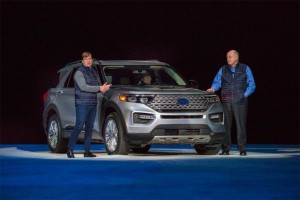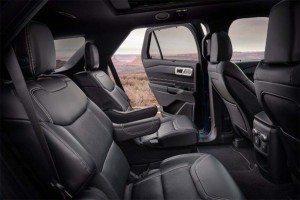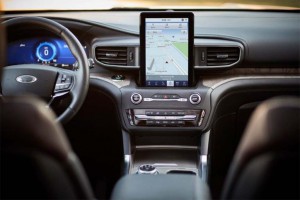From the pint-sized EcoSport up to the yacht-like Expedition, a visit to a Ford showroom reveals an array of utility vehicles wearing the Blue Oval badge, but none carries the gravitas of the Ford Explorer. Since the original rolled out for the 1991 model-year, the Detroit automaker has sold more than 7.7 million of them, making it the best-selling SUV in automotive history.
No wonder, then, that the automaker took over the Ford family-owned Ford Field stadium in downtown Detroit for the first public showing of the all-new 2020 Explorer which will be reaching U.S. showrooms a few months from now. “This vehicle is a beacon for the future” of Ford, said Executive Vice President Jim Farley, as the first of the new SUVs rolled out onto the field.
Starting at $33,000, a modest $400 bump up from the outgoing model, the fourth-generation Ford Explorer is more than just a modest update. Practically everything is new, as the old line goes, from the ground up, starting with a new rear-wheel-drive platform that will be shared with an assortment of other Ford products going forward, starting with the also-new Lincoln Aviator that generated its own buzz during a preview at the Los Angeles Auto Show last month.
The original Explorer was a classic, truck-based body-on-frame SUV. Like the gen-3 model, the new 2020 model officially qualifies as a “crossover,” but Ford took pains to stress that it will boast significant off-road capabilities, especially when ordered in all-wheel-drive, as well as towing capacity of up to 5,600 pounds.
(Ford hints at 2020 Explorer with debut of all-new police interceptor utility. Click Here for the story.)

The new Explorer (shown here with Ford product chief Hau Thai-Tang) gets a new, rear-drive platform and a more dynamic design.
The shift from a fundamentally front-drive to a rear-drive architecture was something that Ford weighed carefully. In the end, explained product development chief Hau Thai-Tang, it offered some key advantages. “In this segment,” he explained, “the number one purchase reason is styling, and the architecture enabled us to get the right proportions.”
During the presentation, Ford officials stressed that despite sharing the new platform, the Explorer and Aviator will get markedly different designs. No more badge engineering, they promised.
What Ford designers and engineers pulled off is impressive, the new Explorer appearing to have a longer, more aggressive hood, but by stretching the wheelbase six inches and, among other things shortening overhangs, especially up front, it was able to actually yield more interior space. There’s added room in each of the new SUV’s standard three rows. The cargo bay has also been widened, Chief Engineer Bill Gubing pointed out during a recent media backgrounder, enough so that one can lay a 4×8 sheet of plywood flat on the ute’s load floor.
Family buyers, meanwhile, will likely appreciate the new easy-entry second-row seats that let even a child gain access to the third row.
Another surprise is the fact that the bigger Explorer is also 200 pounds lighter than the outgoing model – and that without resorting to the sort of radical approach Ford took with the now “aluminum-intensive” F-150 pickup.
In keeping with the realities of today, Ford is betting it can win over potential customers by loading up the tech features. There’s a 12.3-inch digital instrument cluster on mid and high-trim models, as well as an optional, vertically oriented 10.1-inch touchscreen anchoring the center stack.
There’s 4G WiFi that can connect up to 10 devices, plenty of USB ports, three 12-volt sockets and even a 110-volt outlet.
(Click Here for more about the Lincoln Aviator.)
The Explorer will feature a wealth of advanced safety gear, such as the CoPilot 360 system that pushes into near-autonomous territory. It not only automatically brakes when there’s a risk of a frontal collision, but also if a car, bicyclist or pedestrian walks behind the Explorer when backing up.
The system can help keep you centered in your lane while driving and, in a sign of how thoughtfully the new model was engineered, the system will give a little wider berth when driving by a big truck.
Other nice details: a reversible load floor, one side more resistant to mud and dirt, and an “apple catcher,” a lip at the back of the cargo bay that prevents loose items from rolling out. “I don’t care as much about losing an apple,” admitted Thai-Tang, as “that bottle of merlot.”
For those who’ll do more than drive on smooth freeways – whether off-roading or just dealing with a tough winter – Ford’s terrain management control system now offers more selectable modes that instantly adjust a range of vehicle functions to optimize traction and maneuverability.
In terms of powertrains, there are two initial options, though Ford is hinting there’ll be more, Farley dropping a line about an “electrified” version during the Wednesday night unveiling.
For the moment, we know about a turbocharged 2.3-liter EcoBoost inline-four that gets a bump from 280 horsepower in the old SUV to 300 now, torque holding at 310 pound-feet. For those who need more performance and the full 5,600 pounds of towing capacity, there’s also a 3.0-liter EcoBoost option that replaces the Explorer’s old 3.5-liter six. It makes 365 hp and 380 lb-ft. Both engines are paired with Ford’s latest 10-speed automatic gearbox.
The basic package puts power through the rear wheels, and Ford expects that to account for the majority of the new Explorer’s sales. But the all-wheel-drive option should gain a bit more traction, so to speak, the automaker estimating it will make up 40% of sales.
(To see more about Ford being transparent about its turnaround plans, Click Here.)
We’ll get an even closer look at the new 2020 Ford Explorer next week at the North American International Auto Show in Detroit.




